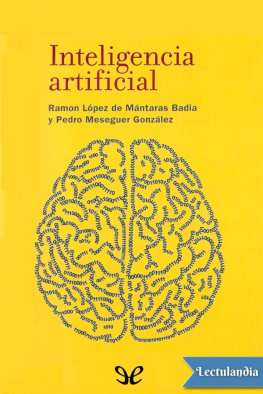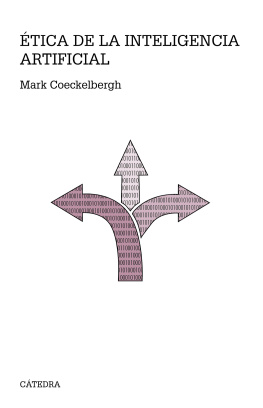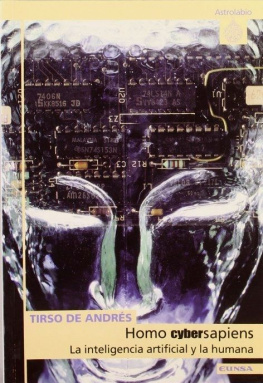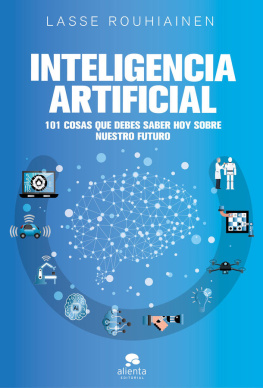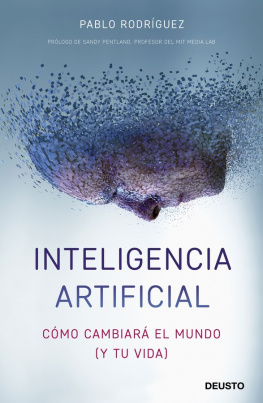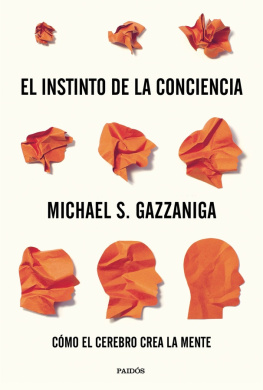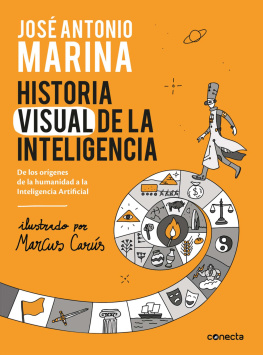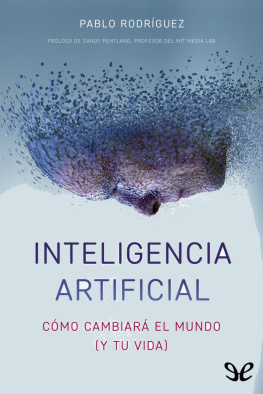
RAMON LÓPEZ DE MÁNTARAS BADIA es profesor de Investigación del CSIC y director del Instituto de Investigación en Inteligencia Artificial. Máster en Ingeniería Informática por la Universidad de California Berkeley, doctor en Física (Control Automático) por la Universidad de Toulouse y en Ingeniería Informática por la Universidad Politécnica de Barcelona. Es pionero de la inteligencia artificial (IA) en España.
Escritos: El futuro de la IA: hacia inteligencias artificiales realmente inteligentes, 27 de febrero de 2019; La inteligencia artificial y las artes. Hacia una creatividad computacional, 31 enero 2017.

PEDRO MESEGUER GONZÁLEZ es Investigador Científico del Consejo Superior de Investigaciones Científicas (CSIC) en el Instituto de Investigación en Inteligencia Artificial, en donde es jefe del departamento de Lógica. Doctor en informática por la Universidad Politécnica de Cataluña, fue Profesor Titular de la Facultad de Informática de Barcelona.
Ha publicado numerosas contribuciones científicas en las conferencias y revistas más prestigiosas de IA sobre varios temas, con especial énfasis en el razonamiento con restricciones. Ha recibido dos veces el premio al mejor artículo en dos conferencias de IA. Es coautor de un capítulo del Handbook of Constraint Programming.
Bibliografía
ALLEN, J. (1995): Natural language understandings, Benjamin Cummings, San Francisco.
BIERE, A.; HEULE, M.; VAN MAAREN, H. y W ALSH, T (2009): Handbook of Satisfiability, IOS Press, Amsterdam.
BLUM, C. y ROLI, A. (2003): “Metaheuristics in Combinatorial Optimization: Overview and Conceptual Comparison”, ACM Computing Surveys, 35, pp. 268-308.
BOBROW, D. y COLLINS, A. (eds.) (1975): Representation and understanding: Studies cognitive science, Academic Press, Cambridge, MA.
BROWNE, C.; POWLEY, E.; WHITEHOUSE, D.; LUCAS, S.; COWLING, P. I.; ROHLFSHAGEN, P; TAVENER, S.; PÉREZ, D.; SAMOTHRAKIS, S. y C OLTON, S. (2012): “A Survey of Monte Carlo Tree Search Methods”, IEEE Trans. Computational Intelligence and Al in games, 4(1), pp. 1-49.
COLTON, S.; LÓPEZ DE MÁNTARAS, R. y S TOCK O. (2009): “Computational Creativity: Coming of Age” AI Magazine, 30(3), pp. 11-14.
DE LEÓN., M. y TIMÓN, A. (2013): Rompiendo códigos. Vida y legado ele Turing, colección ¿Qué sabemos de?, Los Libros de la Catarata-CSIC, Madrid.
DECHTER, R. (2003): Constraint Processing, Morgan Kaufmann, San Francisco.
DREYFUS, H. L. (1992): What Computers Still Can’t Do: A Critique of Artificial Reason, The MIT Press, Cambridge, MA.
FAUGERAS, O. (1993): Three-dimensional Computer Vision (Artificial Intelligence), The MIT Press, Cambridge, MA.
FEIGENBAUM, E. A. y FELDMAN, J. (eds.) (1963): Computers and Thought, McGraw-Hill, Nueva York, pp. 134-152.
GHALLAB, M.; NAU, D. y TRAVERSO, P. (2004): Automated Planning: Theory and Practice, Morgan Kaufmann, San Francisco.
GARCÍA-ARMADA, E. (2015): Robots, colección ¿Qué sabemos de?, Los Libros de la Catarata-CSIC, Madrid.
GINSBERG, M. (1993): Essential of Artificial Intelligence, Morgan Kaufmann, San Francisco.
HODGES, A. (2012): Alan Turing: The Enigma, Vintage, Random House, Londres.
KOLODNER, J. (1993): Case-Based Reasoning, Morgan Kaufmann, San Francisco.
KOWALSKI, R. A. (1980): Logic for Problem Solving, North Holland Ámsterdam.
LECUN,Y.; BENGIO, Y. y HINTOn, G. (2015): “Deep Learning”, Nature, 521, pp. 436-444.
LÓPEZ DE MÁNTARAS, R. (1991): Approximate Reasoning Models, Ellis Horwood Amsterdam.
LÓPEZ DE MÁNTARAS, R.; MCSHERRY, D.; BRIDGE, D.; SMYTH, B.; CRAW, S.; FALTINGS, B.; MAHER, M. L.; COX, M.; FORBUS, K.; KEANE, M.; AAMODT, A. y WATSON, I. (2006): “Retrieval, reuse, revision, and retention in CBR”, Knowledge Engineering Review, 20(3), pp. 215-240.
MANNING, C. D. y SCHÜTZE, H. (1999): Foundations of Statistical Natural Language Processing, The MIT Press, Cambridge, MA.
MARR, D. (1982): Vision: A Computational Investigation into the Human Representation and Processing of Visual Information, W. H. Freeman and Co, San Francisco.
MITCHELL, T. (1997): Machine Learning, McGraw-Hill , Nueva York.
NEWELL, A. y SIMON, H. A. (1972): Human Problem Solving, Prentice-Hall, Englewood Cliffs, NJ.
NEWMAN, A. (2007): The Correspondence Theory of Truth, Cambridge Studies in Philosophy, Cambridge University Press, Cambridge.
PEARL, J. (1984): Heuristics: Intelligent Search Strategies for Composed Problem Solving, Addison-Wesley, Boston, MA.
—(1988): Probabilistic Reasoning Systems: Networks of Plausible Inference, Morgan Kaufmann, San Francisco.
ROSSI, F.; VAN BEEK, P. y W ALSH, T (eds.) (2006): Handbook of Constraint Programming, Elsevier, Nueva York.
RUSSELL, S. y NORVIG, P. (2010): Artificial Intelligence: A Modern Approach, 3.ª ed., Prentice Hall, Nueva Jersey.
SCHANK, R. C. y ABELSON, R. P. (1977): Scripts, Plans, Goals, an Understanding: An Inquiry into Human Knowledge Structures, Lawrence Erlbaum Associates, Hillsdale, NJ.
SEARLE, J. R. (1980): “Minds, Brains, and Programs”, Behavioral and Brain Sciences, vol. 3, pp. 417-457.
SHORTLIFFE, E. H. (1975): Computer-Based Medical Consultations: MYCIN, Elsevier, Nueva York.
SICILIANO, B. y KHATIB, O. (eds.) (2016): Springer Handbook of Robotics, 2.ª ed., Springer, Berlín.
SUTTON, R. y BARTO, A. G. (1998): Reinforcement Learning: An Introduction, MIT Press, Cambridge, MA.
THORNDIKE, E. L. (1911): Animal Intelligence, The Macmillan Co, Nueva York.
TORRAS, C. (2016): “Service robots for citizens of the future”, European Review, 24(1), pp. 17-30.
TURING, A. M. (1950): “Computing Machinery and Intelligence”, Mind, vol. LIX (236), pp. 433-460.
VAN HARMELEN, E; LIFSCHITZ, V. y PORTER, B. (eds.) (2008): Handbook of Knowledge Representation, Elsevier, Nueva York.
WEIZENBAUM, J. (1976): Computer Power and Human Reasoning: From Judgment to Calculation, W. H. Freeman and Co, San Francisco.
WINOGRAD, T. (1972): Understanding Natural Language, Academic Press, Cambridge, MA.
—(1983): Language as a Cognitive Process, vol. 1, Syntax, Addison-Wesley, Boston, MA.
WINSTON, P. H. (ed.) (1975): The psychology of computer vision, McGraw-Hill, Nueva York.
WOOLDRIDGE, M. (2009): An Introduction to Multiagent Systems, 2.ª ed., John Wiley & Sons, Nueva York.
ZADEH, L. (1965): “Fuzzy Sets”, Information and Control, vol. 8, pp. 338-353.
CAPÍTULO 1
Orígenes de la inteligencia artificial
Los orígenes de la IA no pueden entenderse sin hablar de Alan Turing. Fue un científico clarividente cuya relación con la IA no se limita al famoso test que lleva su nombre, sino que anticipó futuros desarrollos de la IA y, lo que es más importante, intuyó la importancia que jugaría el aprendizaje automático en el desarrollo de la IA al afirmar que, en lugar de intentar emular mediante una máquina la mente de un adulto, quizá sería más factible intentar emular la mente de un niño y luego someter a la máquina a un proceso de aprendizaje que diera lugar a un desarrollo cognitivo de dicha mente hasta alcanzar el equivalente de una mente adulta; es decir, lo que actualmente propone la robótica de desarrollo. A continuación relatamos el nacimiento oficial de la IA en 1956 en un encuentro científico en el Dartmouth College, aunque, como veremos, un año antes ya había tenido lugar una sesión dedicada al tema del aprendizaje automático en un congreso celebrado en Los Ángeles. Después describimos los primeros programas capaces de demostrar teoremas y resolver una variedad de problemas relativamente sencillos. A continuación hablaremos de los primeros programas capaces de aprender, los primeros intentos de procesar el lenguaje natural y los primeros lenguajes de programación.

